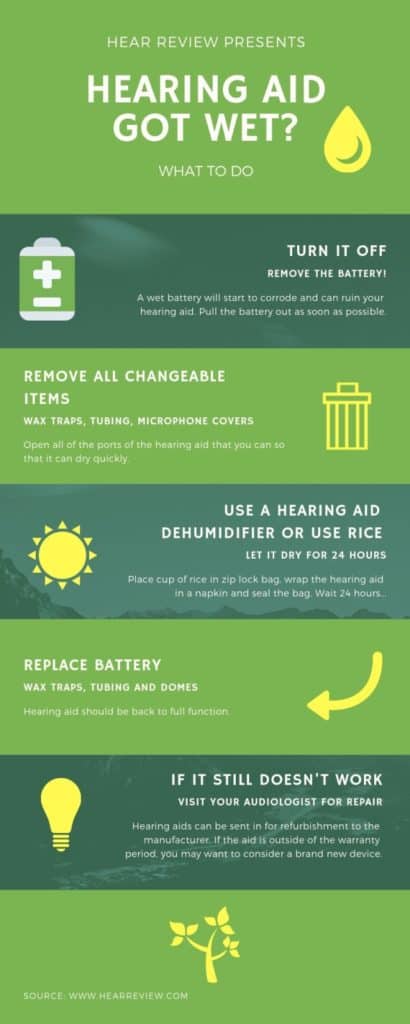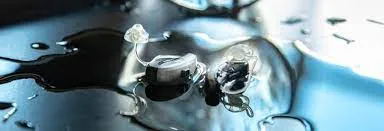Water poses a significant risk to electronic devices, including hearing aids. Whether it’s due to rain, shower, or accidental immersion, it’s crucial to know what steps to take when your hearing aid gets wet.

So, what should you do if your hearing aid gets wet?
- Take out the battery
- Remove the old wax trap, tubing, and microphone covers
- Let it dry out for about 30 minutes
- If it still doesn’t work, place it in a dehumidifier or bag of rice
If your hearing aid is relatively new, it is likely to have an IP68 rating, which means it is dustproof and waterproof. These hearing aids undergo testing by submerging them under a meter of water for 30 minutes. Afterward, they are air-dried, and in most cases, they will work again within 30 minutes. However, it is not advisable to deliberately submerge your expensive hearing aid for testing purposes.
Modern hearing aids are nano-coated with moisture repellent, allowing them to dry quickly.
For the best waterproof hearing aids see my recommendations
If your hearing aid is not new or lacks moisture-repellent features, here are some tips to try and revive it:
- Remove the battery to prevent corrosion
- Remove all replaceable pieces, such as wax traps, tubing, and microphone covers
- Use a hearing aid dehumidifier to remove remaining moisture and let it sit for 24 hours
- If you don’t have a dehumidifier, place the hearing aid in a zip lock bag with a cup of rice. Wrap the device in a paper towel to prevent rice grains from entering and seal the bag. Leave it for 24 hours, allowing the rice to absorb the moisture.
If the hearing aid doesn’t start working after 24 hours, it’s advisable to take it to an audiologist for repair. If it is within the initial warranty period (usually 2 or 3 years), the repair will be free of charge. Otherwise, it may cost up to $300 for the repair. If the device is old or inexpensive, it may be more cost-effective to purchase a new one instead of replacing it.
What to do if your hearing aid has repeated moisture issues.
Moisture can adversely affect electronic devices, causing them to malfunction or stop working altogether. If you live in a humid area or frequently experience perspiration on your hearing aid, it may require repair by the manufacturer. However, newer technology is addressing this issue.
Many hearing aids now come with moisture protection, such as “nano-coating,” which repels moisture. When purchasing a hearing aid, look for an IP68-rated device to ensure the best moisture protection.
If you already have a hearing aid without IP68 rating or prefer one without it, you can take simple steps to dry out the device overnight. Using a hearing aid dehumidifier or dryer can safeguard your hearing aids, optimize their performance, and potentially extend their lifespan, reducing the need for repairs.
There are two main types of hearing aid dehumidifiers: electric dryers and non-electric desiccant dryers. Electric dryers, which can be plugged into the wall or use a fan, employ heat to dry the hearing aid. Non-electric dryers use a desiccant to absorb moisture. Some dryers combine both methods. However, it’s worth considering the potential drawbacks of each type. Electric dryers can make hearing aid tubing go stiff faster and may cause wires to become more floppy for RIC (receiver-in-canal) devices. Desiccant dryers require periodic replacement (typically every 1 to 6 months).
Here are our top three picks for hearing aid dryers:
Serene ReNew Hearing Aid Dry Box

The Serene ReNew Hearing Aid Dry Box (affiliate link to Amazon) is an electric dryer with a sleek and compact design. It not only removes moisture from the hearing aid but also disinfects it using a UV light, which is particularly beneficial if you are prone to ear infections.
- Dryer: Heat
- Features: UV light for sanitation, 3-hour drying cycle
- Benefits: No need to replace desiccants, modern and sleek design, LED light indicates the device is ON, user-friendly
- Disadvantages: Heat may accelerate the wear of hearing aid tubing or receiver wires
Quest PerfectDry Lux

The Quest PerfectDry Lux (affiliate link to Amazon) is another electric hearing aid dehumidifier that uses a fan to circulate air and dry the hearing aids. It also features a UV light for disinfection.
- Dryer: Forced-air fan
- Features: UV light for sanitation, powered by AC adapter or USB connection, 30-minute drying cycle
- Benefits: No need to replace desiccants
- Disadvantages: Somewhat noisy, may be preferable to keep it in a different room than your bedroom
Acu-Life Dri-Eze

The Acu-Life Dri-Eze (affiliate link to Amazon) utilizes a desiccant lining to control moisture.
- Dryer: Desiccant lining
- Features: Disposable, effectively dries out hearing aids
- Benefits: No electricity, batteries, or reactivation required; just replace the jar every 6 months. Inexpensive and easy to travel with
- Disadvantages: Requires replacement every 6 months
Expert tips for caring for your hearing aid dehumidifier.
- Remember to use your dryer every night.
- Open the battery door on the hearing aids before placing them in the dryer. This turns the devices off and allows moisture to be removed from the inside. You can leave the batteries in the battery door if desired, as the dryer has no effect on battery life.
- If your hearing aids are accidentally exposed to water, use the dryer immediately. Consider replacing the batteries and wax traps if they also get wet.
Best of luck with your hearing aids. If you need new aids, please check out our current recommendations.

